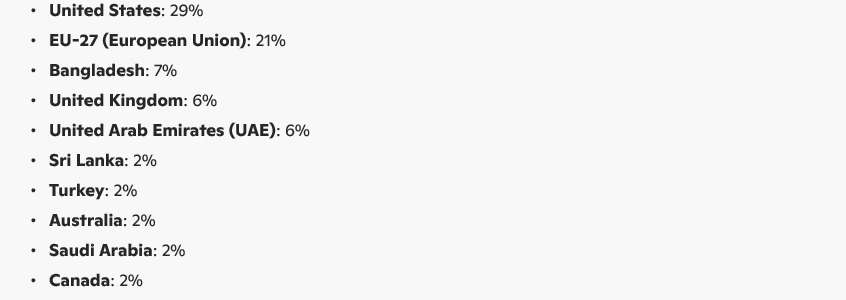India’s top textile exporting countries and their percentage shares are as follows:

The top 10 textile exporting countries for India:
- United States: Consistently the largest market, accounting for a significant share (around 28-29%) of India’s textile exports.
- Bangladesh: A crucial neighboring market, taking around 7-9% of India’s textile exports, likely for their garment manufacturing industry.
- United Kingdom: A significant market in Europe, with approximately 5-6% share.
- United Arab Emirates: An important trading hub in the Middle East, accounting for around 5-6% of exports.
- Germany: A key market within the European Union, taking around 4-5% of India’s textile exports.
- Netherlands: An important gateway to Europe, with around 2-3% share.
- China: While also a major global textile exporter, China is also a significant importer of Indian textiles, with a share that can fluctuate but is generally in the range of 2-4%. Notably, it has been a fast-growing market for Indian textiles in some periods.
- Spain: Another important market within the EU, with around 2-3% share.
- Italy: A country known for its fashion industry, importing around 2-3% of textiles from India.
- France: Another key European market, with an approximate share of 1-2%.
The United States remains the largest market, accounting for nearly a third of India’s textile exports, followed by the EU-27. Bangladesh, as a neighboring country, also plays a significant role in India’s textile trade.
Does this align with your exploration of industry trends? Let me know if you’d like to dive deeper into any specific market!
While precise, real-time quantity data for textile exports from India to specific countries is not readily available in a consolidated public source, I can provide you with the export values for the top destinations based on recent data (primarily for the fiscal year 2022-23 or part of 2023-24, as full FY 2024-25 data is not yet complete).
Here are the top 10 textile exporting countries for India with their approximate export values in USD Million:
| Rank | Country | Approximate Export Value (USD Million) |
|---|---|---|
| 1 | United States | 9,700 – 10,800 |
| 2 | Bangladesh | 2,600 – 3,500 |
| 3 | Germany | 2,000 – 2,100 |
| 4 | United Kingdom | 1,800 – 2,000 |
| 5 | United Arab Emirates | 1,600 – 1,700 |
| 6 | Netherlands | 900 – 950 |
| 7 | Spain | 900 – 920 |
| 8 | China | 800 – 900 |
| 9 | Italy | 800 – 890 |
| 10 | France | 600 – 800 |
Export to Sheets
Important Considerations:
- Data Variation: The exact figures can vary slightly depending on the source and the specific period being reported. The ranges provided above reflect this.
- “Textiles” Definition: The term “textiles” can be broad, encompassing raw materials, fabrics, made-ups, and apparel. The data above generally includes a wide range of these products (HS codes 50-63).
- Quantity vs. Value: It’s crucial to understand that these figures represent the value of the exports, not the physical quantity. The quantity (in units like kilograms, meters, or pieces) is usually more specific to the type of textile product.
- Recent Trends: While the rankings are generally consistent, the specific values and percentage shares can shift year to year due to global demand, economic factors, and trade agreements.
To get precise quantity data, you would typically need to refer to detailed trade statistics from official sources like the Indian Ministry of Commerce and Industry or customs data, which often break down exports by specific product codes and units. These detailed datasets are usually not available in summarized public reports.
Trump reciprocal tariffs effected texile market
The implementation of President Donald Trump’s reciprocal tariffs on April 2, 2025, has significantly impacted India’s textile and apparel industry, particularly affecting exports to the United States. The U.S., being the largest market for Indian textile exports—accounting for approximately 28% of the $36 billion total in FY 2024—has imposed additional tariffs, leading to increased costs for Indian products in the American market. MarketWatchIndia Today
Specifically, Indian exports of textiles, fabrics, yarn, and carpets, valued at $2.76 billion, now face a 6.59% tariff, rendering these products less competitive compared to those from countries like Vietnam and Bangladesh. This shift is expected to result in a decline in export volumes and a potential loss of market share in the U.S.Deccan Herald+2The Economic Times+2mint+2
In response to these challenges, Indian exporters are exploring alternative markets and strategies to mitigate the adverse effects of the tariffs. Diversification efforts and negotiations for trade agreements are underway to sustain and potentially grow India’s textile export sector amidst the evolving global trade landscape.